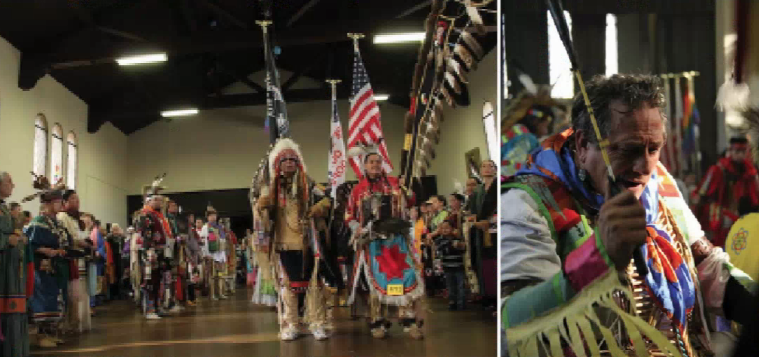Bay Area American Indian Two-Spirit Powwow Brings Everyone Back Into the Circle

Ben Wolf (Marc Dadigan)
Growing up in his primarily Christian Chickasaw tribal community in Oklahoma, Miko Thomas suffered a fear of being rejected for his identity as a Two Spirit, a modern term referring to Native people who are gay, lesbian, bisexual, transsexual or gender variant. Now living in the San Francisco Bay Area, Thomas says that while his relations with some family members are still strained, the struggle to accept who he is became far easier when he learned about the history of Two Spirit people in traditional tribal cultures. Before colonization, many tribes recognized more than two genders (and many still do), and in many cultures Two Spirit people were often healers or had specific societal and ceremonial roles. “It meant my Indian identity and Two Spirit identity weren’t separate,” Thomas says. “It’s important that we acknowledge that history, that Two Spirit people did exist.”
As a member of the Two Spirits pow wow committee and organizer of the second annual Bay Area American Indian Two-Spirit Powwow, Thomas wants to emphasize the importance of recognizing and celebrating that history during the event, which was held February 2 at the First Congregational Church Hall in Oakland, California and drew more than 1,000 people.
Organizers of the event say it’s the only Two Spirit pow wow in the nation that is open to the general public, and it is also a pow wow in which Two Spirit people can feel accepted and even dance in their preferred gender categories without being judged. “There are times when we can feel excluded at pow wows,” says L. Frank Manriquez, Tongva-Acjachemen, a Two Spirit and co-MC. “If a young woman wants to dance in a male category, she’s often met with derision if she’s allowed at all. This pow wow is gently cracking open those gender roles to accept what used to always be accepted in Indian time.”
The Two Spirit pow wow in February began with prayers and songs by local Ohlone people as the event was being held in their land, and a group of indigenous Pacific Islanders sang and provided a blessing as well. In between the competitions, the Queer Danzantes, a coalition of Aztec Dancers that seeks to promote Two Spirit wisdom, performed warrior dances for the fight for love and culture. There was also a touch of comedy as a few game volunteers made their own cardboard and tinfoil regalia and performed outlandish dances as they tried to illicit giggles from the participants of the “Stoic Indian” contest.
The pow wow was open to all dancers and participants, but the head woman dancer, head man dancer as well as Manriquez were Two Spirit people, ensuring their presence at the forefront of the proceedings. The Two Spirit pow wow also loosened the grip of many gender-based conventions of traditional pow wows as the grand entry song was sung entirely by women and many women were drumming, including several members of the Bay Area American Indian Two-Spirit drum group.
“Pow wows are all about self-expression, so what better place to express who you are as someone from the Native and LGBT communities,” says head man dancer Tony Aaron Fuller, a member of the Confederated Tribes of the Colville Indian Reservation. “The Two Spirit pow wow brings a lot of my worlds together, so it’s a special place to be.”
The pow wow, says Navajo Two Spirit Nazbah Tom, was a place where the Western instinct to categorize people can be ignored: they can be Two Spirit, they can be Native and they could be pow wow people as well. In many communities, says Tom, an Oakland resident, it can be dangerous for people to be openly gay, and the pow wow is emblematic in how much progress has been made in restoring Two Spirit history and acknowledging the presence of Two Spirit people in modern Native culture. “I really believe that if our people are a cloth, then the Two Spirit people are the thread that holds it together,” says Tom.
Tom bases this belief on stories shared by trusted elders, and, in this way, she is following in the steps of her Two Spirit ancestors through her work at the American Indian Health Center in Oakland where she provides HIV-testing and counseling and conducts “drama therapy,” a method that uses performance and performance art to facilitate psychotherapy.
In one exercise with a men’s group, she helped the men create papier-mâché masks—on the inside of the masks, they wrote emotions and secrets that they keep hidden but wished they could share. On the outside, they wrote traits of the masculine façade they felt they had to project, such as never showing emotion or vulnerability. “One thing I’ve begun to learn at the age of 33 is that the Two Spirit identity is really beyond our current ideas and notions,” she says. “In English, we want to categorize things and keep them there. But in our Native languages, change is the only constant thing, and that is something we’ve lost with our genders.”
She and other Two Spirit activists have begun talking about a ceremony that would be more deeply emotional than the pow wow and even more affirming: an intertribal Becoming ceremony for young Two Spirits.
It would serve as a counter to the often-painful coming-out experience as well as a way for elders to welcome young Two Spirit people “back into the circle,” Tom says. “We shouldn’t be ashamed of our true selves, and we should celebrate them. So many of us were hurt when we found and announced ourselves, there would be so much healing behind letting them know there’s a place for everyone in the circle.”
Read more at http://indiancountrytodaymedianetwork.com/2013/03/20/bay-area-american-indian-two-spirit-powwow-brings-everyone-back-circle-148264

